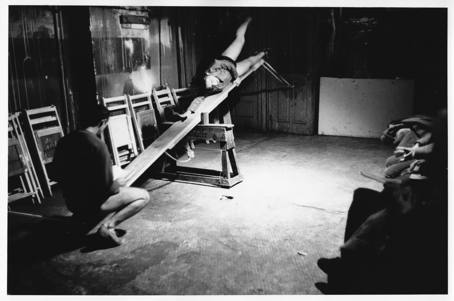Research Project B6. Topographies of the Ephemeral. Choreography as Procedure and Operation
Robert Morris und Yvonne Rainer in: Simone Forti: See-Saw, Dezember 1960, Ruben-Gallery, New-York, Copyright: Robert McElroy, mit freundlicher Unterstützung des Artpix-Dokumentationszentrums
Head
Prof. Dr. Gabriele Brandstetter
Research Associates
Dr. Maren Butte / Kirsten Maar, M.A.
Student Assistants
Objective
In the first research period the project explored movements of transferal within the dissolutions between choreography, architecture and landscape, emphasizing kinesthesia as a specific form of experience for body-space relations.
The focus is now shifted to choreography as a procedure, which – following a set of rules, instructions and matrices – organizes movements of bodies in space and time. In these movements of transference an ’ephemeral product’ is generated.
At the centre of the investigation are the functions of instructions and operations which form choreographic procedures in a double sense as a notation or rule and as the constellation or spatial positioning of bodies. They constitute both the production and aesthetic experience of choreographies. In this understanding, choreographic practices affect not only dance, they can also dissolve into other art forms. In this transference they determine how – as a precondition and effect of judgment – artistic works are experienced.
Sub-Project 1: Choreographic procedures as playing with the unforeseen:Contingency and Improvisation
(Prof. Dr. Gabriele Brandstetter)
The project functions as a point of connection for all sub-projects. It explores the implications of procedures which include improvisation, chance-procedures and practices of contingency. Case studies (for example the approach to dealing with aleatoric concepts in Postmodern Dance, i.e. in the work of Merce Cunningham and Yvonne Rainer as well as in contemporary dance, such as Thomas Lehmens Schreibstück or Xavier LeRoys Projekt) will contribute to a theory of “choreography as procedure” as well as to the modes of reception of aesthetic experience. Furthermore, the project reflects the meta-level of choreography as a procedure, which means the concepts of ’processes of rule-setting?’ In this context the questions of the dissolution of aesthetic limits are opened again: both with regard to choreographic procedures in other art forms and new margins of aesthetic experience, and the fundamental questioning of borders between traditional art genres and art/non-art.
Sub-Project 2: Choreography and Installation Art. Re-Reading Postmodern Dance
(Kirsten Maar, M.A.)
Departing from the choreographers of the Judson Church who aimed to achieve the dissolution of different art-forms and art and everyday life, the project investigates the movements of transference between choreography and installation art. It examines the unfolding of choreographic orderings and procedures in installations, the space-time organizations which govern the relations between objects, setting and recipients, and the transferences of installative orderings in choreographic scores and assignments. This transference is also regarded as a procedure in itself, which determines processes of ’partition’ and participation.
Given the hypothesis that in the confrontation of discursive approaches, economic and political questions, and specific artistic techniques new modes of production evolve in which theoretical and practical knowledge mutually give rise to each other, the procedures of instruction and arrangement will be explored regarding their potential to generate dynamic processes and alternative orders.
Sub-Project 3: On Remnants and Vestiges. A Phenomenology of Remaining
(Dr. Susanne Foellmer)
Starting from the observation that remains do not exist as such, since they are quickly absorbed into new and different contexts of signification, the project focuses on the concept of the remaining within the transitory, which assumes a new constitution within the performative arts. What was formerly regarded as presence-creating, transitory, and by that implicitly critical, is now being preserved in reenactments and performances. This designates a shift from the presence of performance to modes of (self-) archiving processes, which also concern questions of commercialization. Pieces of memory, relics and documents are more and more often becoming part of dance, performance and exhibitions. These remnants hold an ambivalence, an excessiveness and indefiniteness, whereas at the same time their uncertain status allows new contextualizations. How far are the ideas of presence and of the processes of ordering being reflected in such belated arrangements? And in which way do the cut-off processes and the re-utilization of remains present themselves as a performative cultural technique?
Sub-Project 4: Processes of Choreographic Orderings/Constellations in the Work of Jan Fabre, Christina Caprioli and Bruce Nauman
(Dr. Maren Butte)
The project is dedicated to exploring the work of Jan Fabre and Cristina Caprioli, which oscillates between theatre, choreography and installation. It will be analyzed from a perspective on the procedure of choreographic ‘ordering’ which implies a double-sense of ‘order as assignment’, as a (written) concept or score and ‘order as constellation’ in the sense of creating a relation between movement, space, language and object. The objective is to examine the specific relational and ephemeral aesthetic experience which is generated here for the audiences. The theoretical concept of the grain (de la voix by Roland Barthes) will – dance-specifically transformed – serve as tool to analyse and describe the simultaneity of different modes of perception. The analysis also implies examining the transferal of choreographic strategies into the medium of video and vice versa. Contemporary choreographic examples will be contextualized here with a revision of historic movement-experiments (Bruce Nauman, Merce Cunningham).
